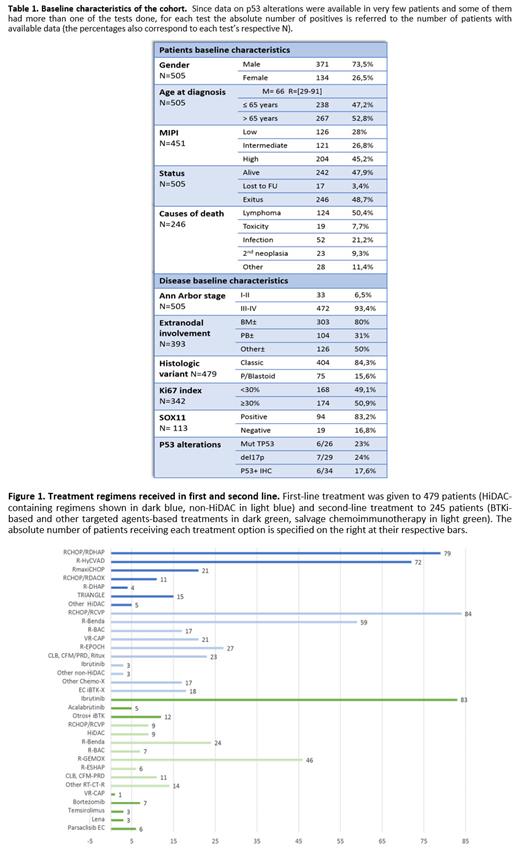Background: MCL remains incurable and its management is highly heterogeneous due to the lack of standard treatment. Since the results from prospective clinical trials are not always reproducible in real-life patients, the aim of this study was to analyze the management in clinical practice of patients with MCL in Spain and its impact on their survival.
Methods: We retrospectively analyzed the clinical-biological characteristics and treatment patterns of patients (pts) with MCL from Spanish GELTAMO centers and their impact on overall (OS) and progression-free survival (PFS). First-line treatments (1L) were grouped as HiDAC (high-dose cytarabine or HiDAC-based) or non-HiDAC; second-line treatments (2L) as BTKi (BTK inhibitors), CIT (chemoimmunotherapy) or other (targeted agents other than BTKi). In patients receiving 1L at diagnosis, early progression/relapse (E-POD) was considered when occurring within 24 months (m) from diagnosis and late or L-POD beyond 24 m or no relapse at data cut-off. A follow-up time (FU) of ≥24m was required for patients to be evaluable for POD, except for those dying from MCL <24m, recorded as E-POD. Statistical analyses were performed with the R-4.1.0 software.
Results: From January 2000-March 2023, 505 patients were diagnosed with MCL in 17 GELTAMO centers, their baseline characteristics are summarized in Table 1. At data-cut-off, 242 (47.9%) were alive, 17 (3.4%) lost to FU and 246 (48.7%) had died, being the lymphoma the main cause of death (50.4%).
Sixty-five (12.8%) pts did not receive treatment at diagnosis, out of which 18 (28%) remain on observation at a median (M) FU=26 m (3-92). Out of 479 pts receiving 1L, 245 (51%) received 2L, 143 (30%) 3L, 75 (15.6%) pts 4L and <10% received 5-8 lines. Among 432 pts treated upfront (no observation prior to 1L), 423 were evaluable for response: 190 (44.9%) HiDAC and 233 (55%) non-HiDAC, with a predominance of anthracycline-based treatments (Figure 1). Overall (OR) and complete responses (CR) were higher with HiDAC vs. non-HiDAC (91%/78.4% vs. 82.8%/65.2%, respectively). In 394/432 pts evaluable for POD (149 E-POD and 245 L-POD), HiDAC was more frequently associated with L-POD (73.2% L-POD vs. 26.8% E-POD) than non-HiDAC (53.1% L-POD vs. 46.9% E.POD). Rituximab maintenance (RM) was given to 167 pts (prior HiDAC 48.5%, non-HiDAC 51.5%) and 80.7% of them were L-POD. ASCT was performed in 135 pts (prior HiDAC 83.7%, non-HiDAC 16.3%, followed by RM in 46%) and 86.1% were L-POD. In 2L, 232/245 were evaluable, 92 (39.6%) received iBTK (60 monotherapy, 11 with CT and/or rituximab), 122 (52.6%) CIT (bendamustine-based 24.6%, gemcitabine-based 36.5%) and 18 (7.75%) other salvage options (Figure 1), with no significant differences between iBTK and CIT regarding baseline characteristics or efficacy (OR/CR 60.8%/39.1% vs. 72%/56.5% for BTKi and CIT, respectively).
With a M FU= 87.6m, M OS= 6.56 years (5.6-8.2) and M PFS= 34.3 m (29.86-43.43). Age>65 at diagnosis (HR=2.09, p<.001), blastoid variant (HR=1.77, p=.012), Ki67≥30% (HR=1.93, p=.001), non-CR after 1L (HR=2.20, p<.001) and E-POD (HR=5.21, p<.001) were associated with shorter OS (MVA) and blastoid variant (HR=1.83, p=.001) and Ki67≥30% (HR=1.65, p=.003) with PFS. ASCT and RM were significantly associated with longer PFS (HR=0.33 and HR=0.32, p<.001) in the MVA but only MR had impact on OS (HR=0.62, p=.031). After 2L, M OS-2= 30.01 m (25.23-46.42) and PFS-2= 12.42m (8.97-17.02), with no impact of BTKi in 2L (vs. CIT) on OS-2 (HR=0.64, p=.12) or PFS-2 (HR=0.73, p=.12). E-POD and HR-MIPI, however, were significantly associated with shorter OS-2 (HR=1.72, p=.03 and HR=2.08, p=.03, respectively) and PFS-2 (HR=1.91, p<.001 and HR=1.88, p=.005 respectively).
Conclusions: The impact on survival of known risk factors such as older age at diagnosis, high Ki67, HR-MIPI, blastoid morphology, non-CR after 1L or E-POD was confirmed in our series, as well as the advantage in efficacy and risk of E-POD of HiDAC-based regimens vs. non-HiDAC in 1L. Regarding RM and ASCT in 1L, our results are in line with other studies, with RM associated with longer PFS and OS and ASCT showing advantage in PFS but not in OS. In 2L, the rate of OR/CR with BTKi in our cohort is like that reported in pivotal studies, but we did not find the survival advantage of BTKi over CIT observed in other retrospective studies.
Disclosures
Marin Niebla:Janssen: Consultancy, Honoraria; Roche: Consultancy; AstraZeneca: Consultancy; Takeda: Consultancy, Honoraria; Kiowa Kirin: Consultancy; Kite: Consultancy, Honoraria; Lilly: Consultancy, Honoraria. Bastos-Oreiro:BMS, Kite, Novartis, F. Hoffmann-La Roche Ltd, Incyte, Abbvie: Honoraria, Speakers Bureau; SEHH, AMHH: Membership on an entity's Board of Directors or advisory committees; F. Hoffmann-La Roche Ltd, Kite, SEHH, AMHH: Research Funding; Incyte, Kite: Consultancy; Gregorio Maranon Hospital: Current Employment, Membership on an entity's Board of Directors or advisory committees. Cabirta Touzón:Janssen: Honoraria; AstraZeneca: Honoraria; BeiGene: Honoraria; AbbVie: Other. Hernandez Rivas:Abbvie, AstraZeneca, Beigene, Celgene, Eli Lily, Janssen, F Hoffman La Roche: Consultancy, Other: Advisory Board. Bosch:Takeda: Consultancy, Honoraria; Karyospharm: Other; Celgene: Consultancy, Honoraria; Roche: Consultancy, Honoraria; Beigene: Consultancy, Honoraria; Lilly: Consultancy, Honoraria; Mundipharma: Consultancy, Honoraria; Gilead: Consultancy, Honoraria; Abbvie: Consultancy, Honoraria; Janssen: Consultancy, Honoraria; AstraZeneca: Consultancy, Honoraria; Novartis: Consultancy, Honoraria. Abrisqueta:Abbvie: Consultancy, Honoraria, Speakers Bureau; Incyte: Honoraria, Speakers Bureau; Janssen: Consultancy, Honoraria, Speakers Bureau; Astrazeneca: Consultancy, Honoraria, Speakers Bureau; Beigene: Consultancy; Roche: Consultancy, Honoraria, Speakers Bureau; BMS: Consultancy, Honoraria, Speakers Bureau.


This feature is available to Subscribers Only
Sign In or Create an Account Close Modal